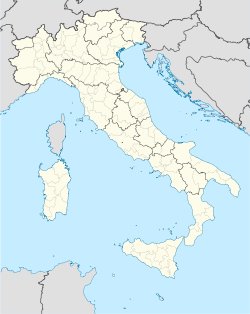- Cianciana
-
Cianciana — Comune — Comune di Cianciana 
Coat of armsLocation of Cianciana in Italy Coordinates: 37°31′17″N 13°26′04″E / 37.52139°N 13.43444°ECoordinates: 37°31′17″N 13°26′04″E / 37.52139°N 13.43444°E Country Italy Region Sicily Province Agrigento (AG) Government - Mayor Salvatore Sanzeri Area - Total 37.7 km2 (14.6 sq mi) Elevation 390 m (1,280 ft) Population (2005)[1] - Total 3,776 - Density 100.2/km2 (259.4/sq mi) Demonym Ciancianesi Time zone CET (UTC+1) - Summer (DST) CEST (UTC+2) Postal code 92012 Dialing code 0922 Patron saint Saint Anthony of Padua Saint day June 13 Website Official website Cianciana is a comune (municipality) in the Province of Agrigento in the Italian region Sicily, located in the middle valley of the Platani river, about 70 km south of Palermo and about 25 km northwest of Agrigento. The Monte Cammarata (1,579 m), part of the Monti Sicani chain, is nearby.
Cianciana borders the following municipalities: Alessandria della Rocca, Bivona, Cattolica Eraclea, Ribera, Sant'Angelo Muxaro.
Contents
History
According to local chronicles, a town known as La Ferla existed in the area in 1269. This was likely destroyed by an earthquake. Archaeological excavations have found traces of Roman temples and other constructions, including a "castle" called Casaletto di Chincana, whence the name given to the area in the feudal era of the Kingdom of Sicily.
Cianciana itself was founded on October 4, 1646 as Sant'Antonio di Cianciana, under the aegis of the Joppolo feudal family. In 1713 it had 2,303 inhabitants.
The town was featured on the UK Channel 4 show "Location". Within the town there has been an increase in British and a growing multinational population buying homes. It is becoming a very popular town for expatriots with a growing number moving there permanently.
Demographic evolution

Monuments and places of interest
Cianciana and its territory, contains valuable evidence of its past and numerous places of interest as well as an artistic nature.
Religious Architecture
There are several building for Catholic worship. The two buildings below no longer exist.
- Church of the Blessed Sacrament (fifteenth century). It was built between 1584 and 1608 in the feud between the current Cianciana C.so Vittorio Emanuele and Via Fidanza. After the construction of the Mother Church, it was used as a hall of the Congregation of the Blessed Sacrament. Today the original building no longer exists, but a new one is home to the Oratory Youth Gerlando Don King.
- Church of San Gaetano (eighteenth century). It was built in the eighteenth century by the efforts of Father Felix Vincent Sedita near Mount Calvary. The church was demolished more than a century ago.
Churches
- Holy Trinity Mother Church (17th century). The church was built by Baron Jerome Ficarra in 1640 and completed by the Joppa family. Originally it had a nave and in 1823 two aisles were added. The vault of the nave was frescoed by the painter Caramel De Simone in 1839.nside there are, among others, two works of art: the statue of St. Anthony of Padua, the famous sculptor Jerome Bagnasco and the statue of marble of the Madonna Free Sick of school Gagini. Attached to the church is the Chapel of the Blessed Lady of Sorrows and Holy Cross, built in 1741 , which houses a large painting of Father Fedele Tirrito, The Deposition.
- Carmine Church ( XVIII century ). The church has a small nave, with a facade that features a triple lancet window placed above the portal. The apse is decorated with small floral stucco and fresco painters of Galeoto and Farruggia .
- Purgatory Church (18th century). The church is dedicated to the Holy Souls in Purgatory and located in the town centre next to the Clock Tower. It was built in 1716 . The building of neoclassical style, is characterised by a portal in the limestone above which contains a fake rose painting. It houses a valuable statue of the Risen Christ School of Bagnasco.
- St. Anthony Church (17th century). The church was built by Prince Joppa was given to the Friars Minor, was opened for worship in 1866. It has adjoining rooms for a convent. The building is rectangular, has a single nave ending in an apse. The construction can be described as an example of Sicilian Baroque. The Church contains, in addition to fine wooden statues, a painting of St. Anthony of Padua, painted on wood and a large painting representing the Madonna apparel painted by Accursio Tower. In 1962, after nearly a century of shabby neglect, the church was reopened and erected as a parish.
References
External links
Sicily · Comuni of the Province of Agrigento Agrigento · Alessandria della Rocca · Aragona · Bivona · Burgio · Calamonaci · Caltabellotta · Camastra · Cammarata · Campobello di Licata · Canicattì · Casteltermini · Castrofilippo · Cattolica Eraclea · Cianciana · Comitini · Favara · Grotte · Joppolo Giancaxio · Lampedusa e Linosa · Licata · Lucca Sicula · Menfi · Montallegro · Montevago · Naro · Palma di Montechiaro · Porto Empedocle · Racalmuto · Raffadali · Ravanusa · Realmonte · Ribera · Sambuca di Sicilia · San Biagio Platani · San Giovanni Gemini · Sant'Angelo Muxaro · Santa Elisabetta · Santa Margherita di Belice · Santo Stefano Quisquina · Sciacca · Siculiana · Villafranca SiculaCategories:- Cities and towns in Sicily
- Municipalities of the Province of Agrigento
Wikimedia Foundation. 2010.



